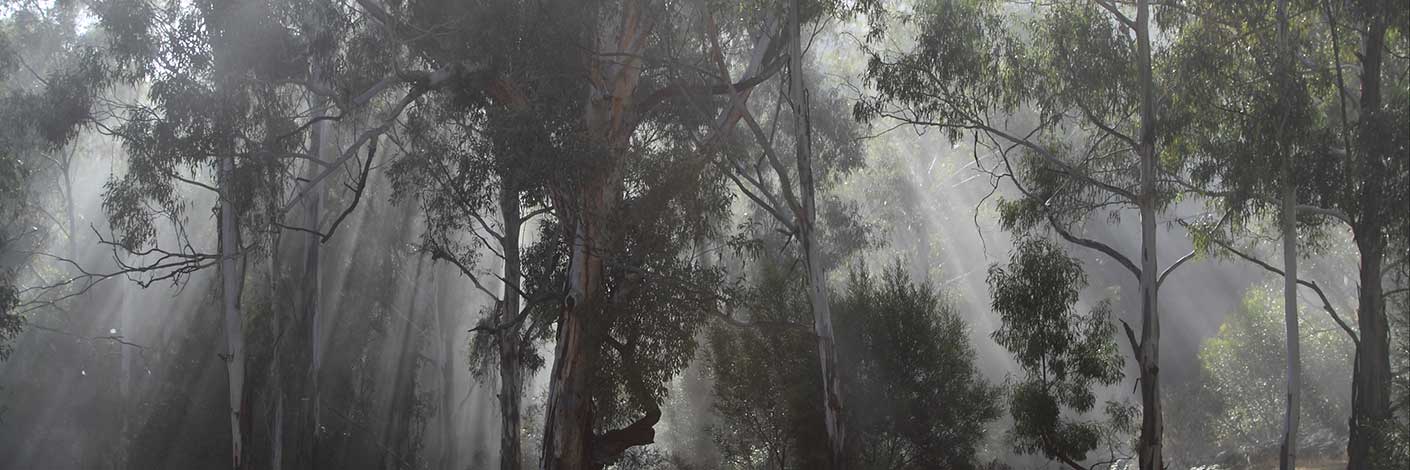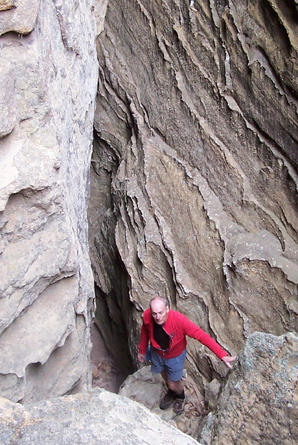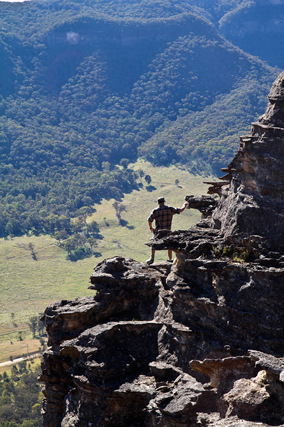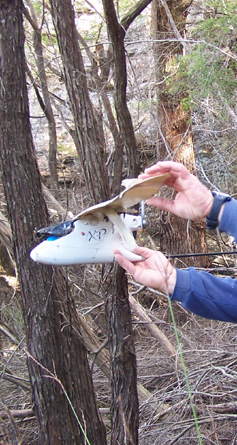Bush Explorers Encyclopaedia
Pandoras Ravine
Is a long, continuous ramp through about 60m of vertical descent from Witches Watch near the western side of the track to Mount McLean down into Hecates Cauldron. At the base and to the north of it, a 3m long tunnel leads into a chamber with five amazing, separate, hidden, almost dry waterfalls / ravines which feed into it. Michael Keats on a Bush Club walk, 5th March 2011 named both these features, the latter, Pandoras Box.
Panoramic Hill
Has a height 1180m, on which Bald Trig Station is located, is now known as Bald Hill. Named by Surveyor Robert Hoddle, 20th October 1823. Ref: Colville, Berres Hoddle. Robert Hoddle Pioneer Surveyor 1794-1881, 2004, p. 43.
Panther Gully
Is a short 400m tributary on the eastern side of Coopers Creek, which in turns flows into Dumbano Creek. Peter Fox, a member of the National Parks Association, named this gully at a time in the late 1990s when the supposed sightings of Lithgow Panther grabbed media attention.
Pantoneys Crown *
Is a spectacular isolated sandstone mesa 7.5km north east of Ben Bullen. Having a height of just over 1020m, it rises over 300m above its surroundings. The closest road is Crown Creek Trail, 2km to the east. Geographical Names Board notes on 27th August 1970 record, "District surveyor advises it is locally referred to and abbreviated as, The Crown. Shown on the map Parish of Goollooinboin, 1884 as Pantony's (sic) Crown or Tower Mount. Named after William Lee (Pantoney) (1794-1870), son of William Pantoney and Sarah Smith, convicts. William married Mary Dargin in 1821 and they had 4 daughters and 6 sons. Ref: Bathurst Pioneers. It was the Aborigines that were employed by Lee who guided him to the Capertee region; they also showed him other promising pastures. Lee established a sheep grazing property in the Capertee area in 1823. Ref: Gresser, P. J. The Aborigines of the Bathurst District. Harvey, Jan and Gerald. The Glen Alice School Centenary, 1884-1984, 1984, p. 57. He was known as William Pantoney Junior until c1817, when he changed his name to William Lee. His early years were spent on Norfolk Island. He lived at Windsor in 1814 and was issued with government cattle in 1816. In 1818, he was one of the first settlers to receive a 50ac land grant at Bathurst. William Lee became a prominent Bathurst figure and in 1856-59 sat in the first Legislative Assembly as Member for Roxburgh. Ref: NSW Parliament, former members website.
Pantoneys Crown Nature Reserve *
Geographical Names Board name assigned on 2nd September 1977. Placed on National Estate Register on 21st October 1980. Pantoneys Crown Nature Reserve comprises about 3,230ha surrounding Pantoneys Crown. On the 22nd December 1995, this reserve was added to the Gardens of Stone National Park.
Pappys Pass
Is a pass and a 4WD track that lead from the headwaters of Genowlan Creek to the top of Genowlan Mountain. Named after Colin (Col) Maxwell Ribaux, former owner of this land, by his sons. Ref: Correspondence with Karen McLaughlin, 30th November 2009.
Parish of Airly *
Is a lands administrative division within the County of Roxburgh. Eastern side of the Glen Alice Topo Map and western edge of the Upper Turon Topo Map.
Parish of Barton *
Is a lands administrative division within the County of Cook. Edwin Barton (1833-1876) was employed by the NSW Railways as Engineer in charge of Trial Surveys. During the years 1857-1860, he was involved in the proposed route for the western railway line via the Grose Valley. In 1865 he married Georgina Lyon Wolgan Walker. Georgina's father James owned 2000ac in Wallerawang dating back to 1823. Edwin purchased many parcels of land in the Wolgan Valley. A Survey Plan C210.1507, dated September 1863, is just one example of his many early purchases.
Parish of Capertee *
Is a land administrative boundary within the County of Cook. The Parish Map of Capertee, dated 1898, records, Capertee or Bogee River. A part of the Capertee River was also known as The Nile.
Parish of Coco *
Is a land administrative district within the County of Roxburgh. Also see Coco Creek.
Parish of Cook *
Is a land administrative district within the County of Cook. Also see Cooks Creek and County of Cook.
Parish of Gindantherie *
Is a land administrative district within the County of Cook. Also see Gindantherie
Parish of Wollangambe *
Is a lands administrative division within the County of Cook. Sydney Morning Herald, 1st March 1858, records the Wollangambe Creek (sic) was part of the boundary for the Hartley Police District.
Parkers Grotto
Was named by Keith Painter in 2016. The Lithgow Mercury, 3rd November 1937, p. 4, records, “ Mr. Parker is preserving intact a peculiar rock formation alongside the road. It is [a] grotto, and a rounded pillar helps to support the overhanging mass. Mr. Parker declares that the rock face, which looks out to the west and thus has felt the effect of westerlies for centuries, has been sand blasted into this curious shape. In years to come many a motorist and pedestrian will halt to observe Nature's handiwork." Located off Hassans Walls Road approximately 100m towards Browns Gap from the signposted junction to Hassans Walls Lookout.
Pavilion Gully
Is located on the western side of Hassans Walls Lookout and below the communication towers and shelter shed at Hassans Walls, Lithgow. A track down this gully used to connect with the walking track below. An old fireplace is near the top of this very overgrown track. Lithgow Mercury, 8th December 1916, p. 6. Pavilion Gully was actually mined under as late as 1970 onwards by Lithgow Valley Colliery, who were granted a mineral lease (ML20) under the reserve in March 1970.
Peak Harvey
Is located 950m south west of Mount Harvey and 2.7km north east of Hughes Defile within the Gardens of Stone National Park, at an elevation of 970m. So named on a memorial walk to Peter (Pete) Kristen Harvey (1982–2013) by the Sydney University Bushwalkers, 11-12 May 2013. Part of their track notes record, “In the morning we struck out early for Mt Harvey but due to the large group size, pathological pagodas, and a misplaced scrambling rope, wemade it only so far as the large rock structure…This is a sublime spot with magnificent views not only of Mt Harvey, but of the Red Rocks, the Crown, Tayan Pic and the Capertee to the north. We held a quick group discussion and unanimously decreed the point as Peak Harvey, named after the man whom we chased up so many a peak. We installed a logbook and shared a terrible sombre too-early farewell to our dear friend, in a beautiful beautiful part of the world”. Peter had served the club in many roles including a term as president.
Pearsons Lookout *
Is one of the finest vantage points to view the southern end of the Capertee Valley. Located on the eastern side of the Castlereagh Highway, 2.5km south east of Capertee and 6.7km north west of Ben Bullen. The panorama (on a clear day) from left to right is Mount Airly, Genowlan Mountain, Cottage Rock, Mount Innes, Mount Iris, Mount Gundangaroo, Mount Canobla, Point Anderson, Red Rocks, Point Nicholson, Mount Dawson, Mount Harvey, Mount Stewart, Mount McLean and Mount Jamison. It is highly likely that this lookout was named after John Westall Pearson. He was listed as Director and Chairman of the Commonwealth Oil Corporation, 1919. He was involved in commercial aspects of the mining at Blackmans Crown (near opposite Pearsons lookout), as well as at Newnes and Glen Davis. Ref: Oil and Petroleum Manual, 1920, p. 54. SMH, 25th December 1912, p. 12.The State Library of NSW holds a photo titled Capertee Valley from Pearsons Lookout, dated December 1937. A directional plaque was erected at this lookout but has long since disappeared. Major road upgrades to this lookout were completed in June 2013.
Pegasus Rock
Was named by Michael Keats on a Bush Club walk, 30th August 2103. Michael recorded,"I looked up at the pagodas and there is a special piece of magic in stone, a flying horse no less, riding / flying and silhouetted against the sky". Located on the top of the cliff line, 1.3km north east of Invincible Trig Station.
Penrose Cave
Is located underneath the eastern cliff line of Penrose Gully, 1.5m east, south east of the propertyKoopartoo. The overhang is in the shape of a semicircle with a 30m radius, and about 30m high at the drip line. It has a flat balcony level, about 3m wide, that runs all the way along the back wall, and a sloping floor level underneath it. Named by Yuri Bolotin on a bushwalk on 30 September 2017.
Penrose Creek
And / or Gorge are now known as, (see) Tunnel Creek and Bells Grotto respectively. The name Penrose Gorge referred to the gorge on the southern side of the Glowworm Tunnel. The names Penrose Creek and Penrose Gorge were the names used by Henry Deane in his reports on the construction of the railway to Newnes in 1906-1907. Ref: Deane, Henry. The Wolgan Valley Railway - Its Construction, 1910, reproduced by the Australian Railway Historical Society, 1979, p. 17. See Penrose Gully re origin of the name Penrose.
Penrose Gully *
Is a non perennial stream rising about 6km south of Newnes in a cliff lined ravine. It flows generally north and north west for about 2.5km into the Wolgan River. Charlotte Mackay (c1830-1903) at the age of 18 immigrated to Sydney in 1848. She was married to Thomas Penrose (d1901) at Bowenfels in 1850 by the Rev. Colin Stewart. All their children were born in the district, and both Thomas and Charlotte were buried at Wallerawang. Thomas took out a Conditional Purchase of 40ac fronting the Wolgan River in 1869. Ref: Survey Plan 386.1507. It appears that they purchased at least five other parcels of land and placed them in their children's names (Edwin, Robert and Herbert). Ref: Survey Plans 464.1507; 598.1507; 613.1507. Shipping records and BDM's. Also see Sinnamon Creek
Penrose Slot
Is the easternmost entry point into Penrose Gully, access is via Old Coach Road. Penrose Slot was described by Michael Keats on a bushwalk, 29th March 2010 as,"It is a perfect staircase followed by a chock stone tunnel section."
Pentafid
Refers to headwaters of an unnamed creek which feeds from the west into Deanes Creek 1.4km south west of the junction of Deanes Creek and Constance Gorge. The Pentafid is the junction of five tributaries. So named by Michael Keats, 25th November 2009, Michael applying the botanica lname for "cleft into five". Walking access from Glowworm Tunnel Road and Old Coach Road.
Pentafid Defile
Is a ramp like slot on the eastern side of the north rim of the Pentafid which gives access to the top of the cliff line overlooking Deanes Creek. Road access via Old Coach Road and Tiger Snake Canyon Track. So named on a Bush Club walk by Brian Fox, 30th October 2015.
Peoples Palace
Refers to the cliff line above the northern side of the Wolgan Road, opposite and between Penrose and Zobels Gully. Name recorded in Taylor, Pete and Penney, Andrew. The Wolgan Guide, 1984, p. 150 and 165. This area has been climbed from 1978.
Perforated Dome
So named as a dozen natural stone windows grace the top of this pagoda. The dome is about 3 m in diameter. Located 1.4 km south east of the barrier (Newnes State Forest and Blue Mountains National Park) on Waratah Ridge Road. Named by Michael Keats on a Bush Club walk, 21st August 2014.
Perforated Spur
Is a short 700 m spur on the southern side of Waratah Ridge between Zig Zag Spur and Scatters Ridge. The start is 1.2 km from the barrier at 489 022, and it extends south to 490 015. Named by Yuri Bolotin on a bushwalk, 12th June 2015 after the feature, Perforated Dome, located at the end of this spur.
Permafrost Gully
Is generally a south facing gully, 1km in length, located 1.5km north of the State Mine Museum. The State Mine was also within this gully. The gully is exposed to the biting winds, severe frost and, in harsh winters, ice that does not melt during the day. This gully in which the State Mine was located was locally known by a number of other names which included Snake Gully , Steak Knife Gully, Dobbs Drift and The Drift. Ref: Stephen Imrie, correspondence of 6th January 2010.
Petries Balcony
Refers to a 800 m ledge between two cliff lines above and on the eastern side of Petries Gully. Access to the ledge, which varied from one to ten metres wide, is via a rock climbers chain, GR 439 269. Named by Michael Keats, Brian Fox and Yuri Bolotin on a bushwalk, 22nd August 2016.
Petries Gully *
Is a watercourse rising about 3.5km south west of Glen Davis. It is about 3km in length and flows generally south, then south east into the Wolgan River.This gully has also been referred to as Shale Gully. Ref: Shown on Carne, Joseph. Geological Map of the Capertee and Wolgan Valleys, 1901. James Ramsay Petrie (1851-1924) and his brother William (b1845) were born in Fifeshire, Scotland. James was the manager of Pumpherston Oil Works, Mid Lothian, for 25 years. In 1910, the Commonwealth Oil Corporation was formed in London to work the vast oil shale deposits at Newnes. James was employed by the company as director and advisor in the manufacture and distillation of oil at the Newnes site. William Petrie was employed as a retort superintendent and works manager. Ref: The Sydney Morning Herald, 22nd August 1924, p.11 and Local History Library, Blackburn, West Lothian, Scotland.
Petries Gully Cliffs
Refers to the cliff line above the junction of the Wolgan River and Petries Gully. Named by Thomas Ebersoll, owner of the old Newnes Hotel, and shown on his hand drawn map The Newnes Area, 2005.
Petries Point
Is located directly above the the junction of Wolgan River and Petries Gully at 800m. Extensive views of Petries Gully and Wolgan Valley. Named by Yuri Bolotin on a Bush Club walk 14th July 2016.
Petries Slots
These east-west trending features form a cross cut saw pattern over much of the narrow plateau between the eastern side of Petries Gully and the Pipeline Track. They are not shown on the topographical map as they are too small for the scale of the map, but delineated in the aerial photograph on the reverse side of the current map. Named by Yuri Bolotin on a bushwalk, 7th March 2016. One pass within this area is known as Petries Slots Pass (see separate entry).
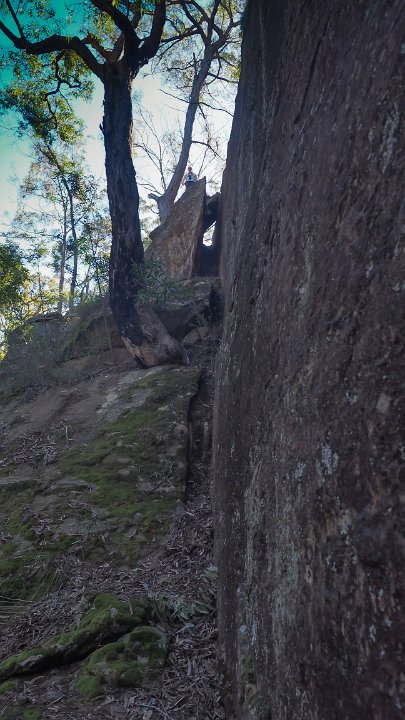
Petries Slots Pass
This pass was named by Yuri Bolotin on a Bush Club walk 18th August 2016. This pass provides an eastern access from Petries Gully to the network of slots (Petries Slots) on the narrow plateau above and hence a return via the Pipeline Track. Described by Michael Keats as, “ a pass within a geometrically precise parallel sided slot complete with a chockstone. Climbing in it required good chimneying skills and some patience as the options for gripping the sides were minimal.”Leading to the pass and at the top of the pass, there are multiple stone cairns, all very old, as mosses and dirt had built up around them.
Petrolea Vale
(From Petra = rock and Oleum = Oil), also see Hartley Vale During the period when oil was being extracted from shale oil (torbanite) between 1865 to 1870 Hartley Vale was known as Petrolea Vale. Ref: Pells, Philip and Hammon,Philip. The Burning Mists of Time, 2009, p. 35. The Goulburn Herald and Chronicle 25th November 1865, p. 5. At Hartley Vale two companies were launched within months of each other in the second half of 1865, first the Hartley Kerosene Oil and Paraffine Co. Ltd., then the Western Kerosene Oil Co. The HKOPCL made the initial running, establishing the Petrolea Vale retorts and refinery in the valley and marketing Star brand kerosene. By 1868 the company had sixty employees mostly living in a sizeable private village and a new bench of retorts of a more advanced shape was installed. The Petrolea Vale retorts and refinery closed down in 1870. Ref:www.environment.nsw.gov.au/heritageapp/ViewHeritageItemDetails.aspx?ID=1960033
Pheromone Pass
Is a bush walking pass 2.3km north east from Mount Budgary which leads into Budgary Creek. Named by Michael Keats, 5th August 2009. This pass, along with Frenulum, Ocellus, Lanceolate and Spiracle Passes, all near Mount Budgary, is named after an anatomical part of a Moth. Michael had encountered a large numbers of Moths during his walks on Mount Budgary Plateau.
Philosophers Cave, Philosophers Stone
Are located on a walking track laid out by Thomas Ebersoll and accessed via Little Capertee Creek Camping Ground towards the base of Old Baldy. A large tilted boulder forms a protected dry area that Thomas has named, The Philosophers Cave, and within it, a flat stone, suitable for sitting on and becoming contemplative, in which he refers to as Philosopher’s Stone.
Phil Reed Pass
Is a means of access from the top of Zobels Gully to the top of the eastern cliff line that leads south to the Old Coach Road or north to Constance Point. Phil was a member of Upper Blue Mountains Bushwalking Club who led a walk using this pass in 2008.
Phyllis Creek
Is part of the upper southern tributary of Penrose Gully; it crossed the old railway line. Ref: Name recorded on the original linen tracing for the Wolgan Valley Railway.
Picnic Point
Pillans Lookout
Is an overhang located within Hassans Glen, Hassans Walls Reserve, Lithgow. Access via ledge in Sandford Cave which leads around to small narrow overhang. Sandford is the first cave from the top of the glen. Above this rock is the original location of Braceys lookout and Natural Throne. Named after Robert Pillans (1860-1941) who was the Mayor of Lithgow in 1911-1918 and 1923-1927. Lithgow Mercury, 14th May 1915, p. 4.
Pinch Point Circle
Refers to huge section of cliff that has been separated from the end of Tagine Point and then partly toppled over towards the opposite, southern side, creating hollows and arched walkways. Within this narrow part of the curving canyon, there is a real pinch point, the walls close right in to less than 20m apart, the cliffs tower more than 40m. Named by Michael Keats on a Bush Club walk, 16th May 2013.
Pinnacle Ridge
Is shown on the map The Gardens of Stone Stage 2 Proposal State Conservation Areas and National Park Extensions. Compiled by Karen McLaughlin for Blue Mountains Conservation Society and Colong Foundation for Wilderness, December 2010, previously and officially named as (see entry) Sunnyside Ridge. Cullen Bullen and Lithgow Topo Maps, northern end GR 375 156, southern end GR 375 022.
Pipeline Gully
Is a short 500m gully that links the Wolgan River to the saddle containing Pagoda Lookout and thence onto Green Gully. Named after the Pipeline Track which traverses this gully and connects the villages of Newnes and Glen Davis. Numerous examples of old infrastructure of the former pipeline still exist in the gully.
Pipeline Track
Place That Time Forgot
Refers to a defile oriented north south between Little Rock Island and Rock Island. It is filled with ancient Tree Ferns and fallen logs. What light does get through has to compete with a dense canopy of Coachwood and Sassafras. The sandstone walls are a rose pink, the air cool and the ambience church like. Within this defile is a semicircular embrasure, maybe 6m high, and equally as wide and deep, with a centrally disposed, very fine dripping water source. This mineral rich water has built a magnificent dark red stalagmite about 50cm high. It has a small depression in the top and is in active growth phase. All around the skirt of this single feature is red flowstone. Name coined by Brian Fox and Michael Keats on a Bush Club walk, 20th October 2011.
Plain of Shards
Is an area of rock formations located 400m north, north west of Mount Jamison and 700m south west of Wolgan Trig Station. Named by Rodney Falconer, who was one of the major players in the creation of the Gardens of Stone National Park, November 1984. Rodney named it after a sweeping expanse of bare rock, covered by the scattered remains of ironstone bands as if broken pottery was scattered across it. Other name recorded is The Exploded Pagoda. Ref: Tom Brennan's photo gallery, October 2010.
Platform Rock *
Is a flat rock on the southern side of Gardiners Hill, 4.4km south east of Ben Bullen and 2.5km north of Baal Bone Colliery. This is a descriptive name. Name appears on the 1:63 360 Wallerawang Topo Map,1935. Name assigned by Geographical Names Board, 30th May 1975.
Pleasant View Canyon
Is an 800m canyon located 400m north west of the northern extremity of Birds Rock Trail No. 2, via Sunnyside Ridge Road. Named by Rick Jamieson. This canyon has rock walls covered by the epiphytic rock Felt Fern,Pyrrosia ruprestris. The canyon ends at the cliff line that has wonderful views of Carne Creek. Ref: Jamieson, Rick. Canyons Near Sydney, 2012, 5th ed. p. 67.
Plimsoll Ledge
Is located in the area known as The Barnacles. In keeping with this nautical theme an undercut ledge on the south west side of The Barnacles was called the Plimsoll Ledge. An upper ledge became The Gunwale. Some of the fretted sandstone was delicate beyond belief being similar to very fine porcelain. It extends from GR 494 906 to GR 495 904 before the ledge runs out as a bluff above Bell Creek. Named by Michael Keats and Yuri Bolotin on a Bush Club walk, 14th September 2015.
Point Anderson *
Is a point of land on the escarpment 2km south of Mount Canobla and 3.5km north west of Newnes. Shown on the map Parish of Goollooinboin, 1884. The Sydney Gazette, 15th October 1831, p. 2 records the arrival of Scottish immigrants that included Patrick Anderson and his wife. The Survey Plan B351.691 dated 1837 shows 640ac applied for by Robert Anderson and Lessee Patrick Anderson near Blackmans Crown. NSW Government Gazette, 13th April 1839, p. 455 also records the lease at 20 shillings per acre.
Point Cameron *
Located 1.1km north west of Mount Davidson and Wolgan Trig Station, and 3.8km south east of Pantoneys Crown. Shown on Carne, Joseph. Geological Map of the Capertee and Wolgan Valleys, 1901. In 1892, John Cameron via Conditional Lease held Portions 2, 3 and 11 bounded by the Wolgan River that have a total area of 250ac. Ref: Survey Plan 1930, 1931 and 1932. 1507. Allan Cameron (1812-1898) is buried at Glen Alice Cemetery.
Point Cameron Hotel
Refers to the large series of overhangs and the cave at Point Cameron. Ref: Correspondence with Rodney Falconer, 3rd May 2010. Rodney remembers this as the Point Cameron Hotel. Named c1984.
Point Cameron Pass
Has walking access from the Capertee Valley to Wolgan - Capertee Divide via Point Cameron. It is a pass only to be used for keen and fit walkers. Named by Michael Keats on a Bush Club walk, 15th March 2013.
Point Cornell *
This double headed bluff overlooks the headwaters of Red Rock Creek, 2.2km south of Mount Harvey. Shown on the map Parish of Wolgan, 1st edition, September 1884. The parish map shows the name refers to the total bluff that looks directly down Red Rock Creek between Point March and Mount Harvey.
It appears that the name Cornell is misspelled and that the location was possibly named after John Connell (1851-1889). The Australian Town and Country Journal 1st September 1883, p. 23. SMH 17th August 1883, p. 6. Evening News 17th August 1883, p. 2. Record that a property of 640 acres shared by John Connell, Peter Wallace and James Loneragan as a Mineral Lease, that good quality Kerosene Shale was discovered. This area was in the vicinity of Ben Bullen Range and described as, “7 miles from Capertee 4 miles from the railway”. In 1888 John Connell also made another discovery of kerosene shale in the Marrangaroo Range, 6 miles from Lithgow Ref: SMH 17th July 1888, p. 8.
Other names that were misspelled include Collett Gap, should be Collitt and Mount Horne which is Mount Horn.
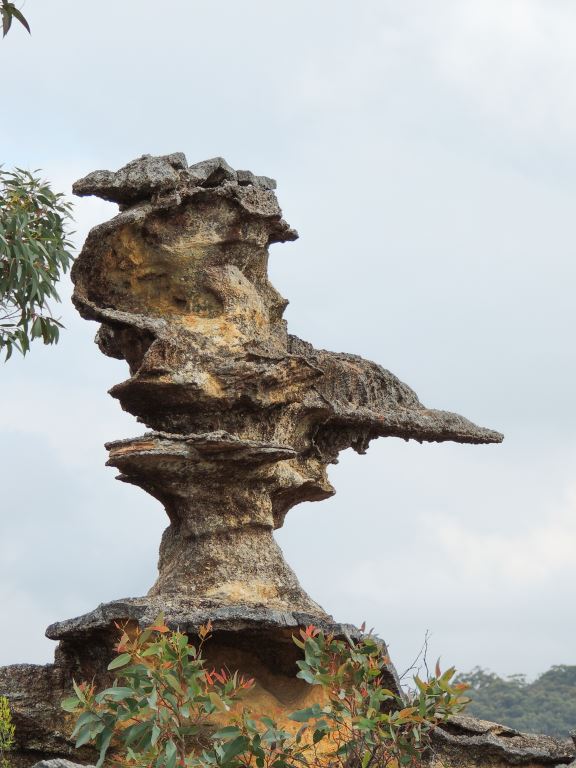
Pointer Rock
Is an elegant plinth that looks like it has been made by a master stonemason; on top of it, is a giant intricately carved sandstone pointer, 1m high, 50cm wide and 1.5m long, its sharp needle end turned towards the natural pass that leads down to Koopartoo Ravine. Located on top of the northern cliff line above the Wolgan River, 1.4km north west of the propertyKoopartoo. Named by Yuri Bolotin and Brian Fox on a Bush Club walk, 22nd May 2017.
Point Green
Point Hatteras *
Is the northernmost point of a bluff, 2.7km east, north east of Mount Airly and 1.8km south west of Genowlan Mountain. The name was first recorded as Cape Hatteras on the Parish of Morundurey, 1916, 4th edition and changed to Point Hatteras on the 1950, 6th edition. The word cape applied to a landform on the coast. It may have been Cape Hatteras which is the easternmost point on United States coastline. But no official origin has been recorded. Changing the name from cape to point is in accordance with the naming of an inland feature.
Point March *
Is a point of land on the western side of the escarpment,1.7km south, south east of Mount Harvey and 1km north east of Point Cornell. John March (1801-1879) purchased 40 acres under Conditional Purchase on the western side of Glen Alice on the 21st March 1878. Ref: Survey Plan R1565.1496. Inscription, Glen Alice Cemetery. Shown on the map Parish of Goollooinboin, 1884.
Point Nicholson *
Located on the escarpment 4.2km west, north west of Newnes and roughly midway between Point Anderson and Gindantherie Pinnacle. Shown on the map Parish of Goollooinboin, 1884. Alexander (1818-1888), Christina (1815-1899) Nicholson and family at the instigation of the McLeans immigrated to Australia in 1857 and settled in the Glen Alice area. Ref: Staff, Bill. Rylstone Area History of Settlement, 1983, p. 68 and inscriptions, Glen Alice Cemetery. One of their sons, Samuel Donald Nicholson, (1843-1944), purchased Portions 80 and 81 in the Parish of Goollooinboin, County of Cook on the 13th and 20th March 1879. Ref: Survey Plan 1061.1507. Another son, John (b1855), held Conditional Purchase on Portions 82-84 in 1878-1879. Ref: Survey Plan 1131.1507. Samuel Nicholson opened the Genowlan Mine near Capertee in 1883. Ref: Carne, Joseph. The Kerosene Shale Deposits of New South Wales, 1903,p. 38.
Point Sol
Point Sutherland
Donald Sutherland was a Consulting Engineer and General Manager of The Commonwealth Oil Corporation Ltd mine and refinery at Newnes in 1906 at the time when the Wolgan Valley Railway was being constructed. The point of land refers to the cliff line above the railway, north of the Glowworm Tunnel and that overlooks the Wolgan Road and the property,Koopartoo , 7kms south of Newnes. Ref: Photo; Lithgow Library, titled, "Wolgan Point Sutherland from Zobels old camp." c1907.
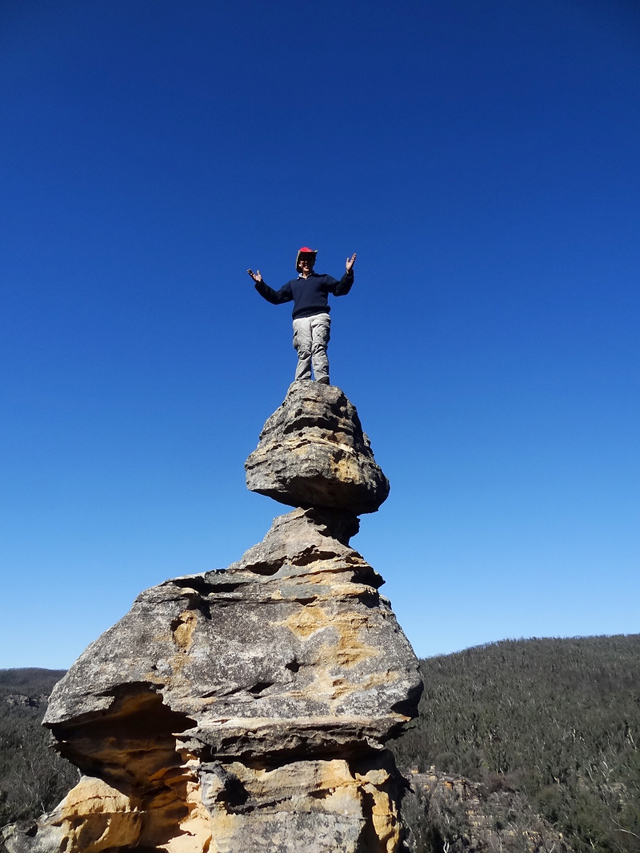
Poised Rock
Is a boulder balancing on the top of a pyramid shaped rock, from a distance it looks like the smallest push would topple it. Located 1.3km east, south east of Dumbano Tunnels. Named by Yuri Bolotin while leading Bush Club walk, 9th February 2014.
Pool of Aphrodite
Is a shallow, crystal clear, 10m diameter pool of water, fed by a 30m waterfall. Located 2.9km east, south east of Cockatoo Hill Trig Station. Access via Deep Pass Trail. Named by Michael Keats on his Bush Club walk, 31st October 2007. Michael described the area as, "shakespearean Romantic, vast and grand, decked with ferns and waterfall."
Pool of Diana
This pool and overhang / canopy is about 40m in diameter. The pool itself is about 30m across and at least 2m deep. The height of the roof above the water surface is approximately 12m. Nearly two thirds of the pool area is under the rock canopy. The uncovered part of the pool is wedge shaped, with the apex dominated by the discharge point of the waterfall. Located 2.5km south east of Cockatoo Hill on a side tributary on the southern side of Dingo Creek. Michael Keats saw this pool on a Bush Club walk, 28th April 2010; named by Yuri Bolotin on a Bush Club walk, 27 July 2012.
Pool of Vestal Virgins
Is a small permanent pool below a small cliff line, overshadowed by tree ferns. Above this pool and small rock face is a tunnel and slots. Located on the western side of Henry Creek 2.4km north, north east of the junction of Glowworm Tunnel Road and Old Coach Road. Named by Michael Keats on a Bush Club walk, 17th August 2012.
Popeye Creek
Has its headwaters on the northern side of Waratah Ridge, 700m east of the end of the vehicular road. This creek flows generally north east for about 3.5km, with many convolutions, into Dingo Creek.
Popeye Falls
Are located midway along Popeye Creek. They have a height of 8m, flowing into a sandy bottom pool. Both names are derived from the canyon name within this creek, Popeye Canyon.
Poppett Cave
Is located 500m north west of Mount Clarence and Clarence Trig Station. It is named after Ken Poppett by his granddaughter Kallie Poppett in 2010. Within this cave are anumber of names and the date 1944. Also a drawing of a kangaroo (non indigenous). The cave is 20m wide, 8m deep and approximately 10m high.
Porch of the Caryatids
Refers to a natural pagoda, located on the cliff top directly above the Main Western Line, between Tunnels No. 9 and 10. This pagoda has been underpinned by eight brick columns to prevent it collapsing onto the railway line below. Named by Michael Keats on a Bush Club walk, 6th February 2012. Caryatids are sculpted female figures serving as architectural supports taking the place of a column or a pillar. One of the best known examples is a porch annex to the Parthenon on the Acropolis in Athens, Greece.
Poseidon Arena
Is a north south trending ridge complex on the south side of Moffitts Trail, between Hades Ridge on the east and Zeus Ridge on the west. The central ridge is Poseidon Ridge. Named by Michael Keats on a Bush Club walk, 16th April 2010. Poseidon was a Greek god of the sea. One of the unusual pagoda formations resembles a Sea Horse, GR 228 187. Near the Sea Horse, there is The Bath of Aphrodite, an almost perfectly circular structure with an elevated rim of ironstone. The Wings of Icarus, delicate, double curved parallel sheets of ironstone, are at GR 229 183. Phoenix Rising is a very delicate formation perched on the edge of the cliff. Other names given to features on this ridge are Hannibals Elephant, a weathered rock formation resembling a dead elephant lying upside down with all four feet in the air, the Walls ofJerusalem, Footprint of the Minotaur,Thors Watch GR 281 122, Toe of Zeus GR 282 186, Orpheus and Eurydice Pagodas GR 289190, Chariot Rock GR 290 188 and Mercurys Boot GR 290 187.
Preemas Pass
Is located off the northern end of Deanes Plateau above Deanes Creek. Named after Alex Pryjma of Lithgow, who walked with National Parks Assosiation. Ref: Correspondence with David Warren Noble, 14th October 2009.
Priory Wall
Providence Rock
Michael Keats wrote, "A little higher up, there is a very large almost cubic rock, cleaved from the main top pagoda, with a cave hollowed out under its northern side. This is where we sheltered from the wind and rain previously to have lunch. Today, while we had lunch, it provided protection from the sun and a cool breeze. I have called this rock Providence Rock". Located above Capertee Creek 2.7km south west of Newnes. Named by Michael Keats on a bushwalk, 1st November 2013. Elevation of 926 m.
Pterodactyl Watch
Refers to an unusual sculptured winged rock formation on the northern side of an isolated pagoda on the eastern tributary of Bungleboori Creek, 1.6km south, south east of Mount Horne. So named by Michael Keats on a Bush Club walk, 24th August 2011.
Pump Hole
Was the local swimming hole near the former township of Newnes. The Pump House was located on the northern side of the Wolgan River at Newnes. Ref: Interview with Dick Bird and Ron Bourke, 29th January 2010. Local usage name by Dick and Ron in the 1940s.The Pump House supplied water from the Wolgan River for Newnes shale works,some distance away.
Pumphouse Cave
Is about 10m long by 10m wide and about 3-5m high. Located near what used to be the original water supply pump for the Newnes Oil Shale operation and close to the water hole known as the Pump Hole on the Wolgan River. Named by Erik Halbert, Sydney Speleo Society, 16th March 2014.
Pyramid Hill
Was the farthest point reached by Surveyor Robert Hoddle, in October 1823. He recorded,"reached a Hill, distant 25 miles from Encampment. The summit was a sandstone rock, in the form of a Pyramid, whose base was 70 feet wide and 50 feet high, which I named Pyramid Hill". Andy Macqueen suggests the hill Hoddle climbed was Birds Rock , via Sunnyside Ridge Road, certainly the highest point in this locality at 1181m. Ref: Macqueen, Andy. Assistant Surveyor Robert Hoddle's 1823 Excursion in the Gardens of Stone - and a Dark Secret? Blue Mountains History Journal, Issue No. 6; December 2015.
Pyramid Pass
Is a natural pass giving access from the cliff line down the western side of Carne Creek near opposite Pyramid Rocks, the huge triangular shaped rocks within Carne Creek gorge. Named by Yuri Bolotin during a Bush Club walk, 22nd May 2014.
Pyramid Rocks
Are isolated rock formations on the eastern side of Carne Creek 1.5km west, south west of road intersection of Glowworm Tunnel Road and Firetrail No. 6. This is a descriptive name coined by Michael Keats on his Bush Club walk, 5th March 2008. The largest of these isolated pyramid shaped rocks is the Great Pyramid. The view from the top is stunning.Two spectacular features in this complex are Cleopatra Needle and Mark Anthony Slot. The GR's are the same as for Pyramid Rocks. All these were named by Michael Keats on a Bush Club walk, 31st January 2014.
Pythagorean Slot
Is a light filled tunnel with a perfectly proportioned triangular profile and aperture. Located on the eastern side of Henry Creek, 2.8km north east of the junction of Glowworm Tunnel Road and Old Coach Road. Named by Michael Keats on a Bush Club walk, 17th August 2012.
Quadrant Rock
Refers to the unusual rock formation which has two 90 degrees slots and appears as though a giant has taken a huge knife and sliced through the rock, then moved a quarter segment out of it some distance. Located on the western side of Ascension Point, and above the northern side of Bungleboori Creek, 3.3km south, south east of the road intersection of Two Trees Road and Waratah Ridge Road. Named by Michael Keats on his Bush Club walk, 7th June 2012.
Queen Victorias Chair
Is a rock formation in the shape of an arm chair on the western side of Blackmans Crown. Stephen Imrie on 10th June 2012 recalled,"this is a favourite spot with the locals."
Raiders Slot
Railmotor Ridge *
Trends east west for about 26km, having Mount Norris on its western end, GR 499 069, and the Wollangambe River on the eastern end, GR 670 043. The spine of this ridge marks the boundary between two national parks, Blue Mountains National Park on the south and the Wollemi National Park on the north.
Rainbow Caves
Is a series of overhangs on the Wolgan - Capertee Divide above Petries Gully, Newnes. The honeycomb weathering is a sculptor's delight and the palette of colours - a painter's dream. Named by Michael Keats on a Bush Club walk, 4th May 2012.
Rain Cave
Is 40m wide, 20m high overhang located off the Glowworm Tunnel Road and Firetrail No. 7. It was first discovered by rock climber Frey Yule on a rainy weekend, c1995. Rain Cave has been described as, "No matter how hard it rains - climbing is always possible at this spot." Named in Pircher, Martin. Blue Mountains Sport Climbing Crags, 1998, 1st edition, pp. 106-107. This overhang was surveyed by Ross Ellis and Erik Halbert on 18th October 2006. Ref: The Journal of the Sydney Speleological Society, 2007, 51 (5); 136.
Rapier Slot
Yuri Bolotin suggested that given the acceptance of Zorro Canyon as a place name then this one should be called Rapier Slot, the rapier being one of the two weapons of choice wielded by Zorro. Located 60m west of Zorro Canyon. Yuri named it on a Bush Club walk, 20th January 2014.
